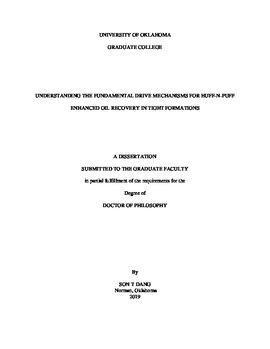| dc.description.abstract | Unconventional oil and gas resources have recently become the major source of produced hydrocarbons in the US. The change in the energy landscape follows nearly two decades of technological breakthroughs including horizontal drilling and hydraulic fracturing. These technologies make the production from tight formations economic. The U.S. used to import more than half of its oil, nowadays it has become the world leading crude producer and net imports have dropped to 11% of total consumption, the lowest percentage since 1957 (EIA). While primary production in conventional reservoirs recovers 20-35% of original volume in place, recovery from tight formations is nominally less than 10% (Hoffman and Evan, 2016). The economic value of hydrocarbons (HCs) left behind in tight formations, including shales, is obvious.
Since 2000, many investigations on Enhanced Oil Recovery (EOR) for tight formations have been attempted in both field pilot tests and laboratory studies. Recent successes of EOR programs from different independent companies confirm the potential of additional HC recovery from tight formations with proper stimulation strategies. Unlike conventional reservoirs, the break-even point for every barrel of oil produced from tight formations is relatively high; therefore, to make EOR in unconventional reservoirs possible, it is essential to optimize every step of the stimulation, including the selection of reservoir candidates, suitable EOR methods, and the optimal operational implementation for the selected methods.
In this study, we introduced a workflow to evaluate EOR potential of a play, including three phases: phase 1 – rock and fluid characterization, which provides the foundational knowledge for phase 2 - EOR feasibility screening and phase 3 - fundamental understanding, which helps to define key factors governing the success of EOR huff-n-puff in shales. The EOR potential of a play strongly relies on how much is removable HCs would be left behind in a formation after primary production. Therefore, in situ fluid compositional analyses and rock petrophysical measurement needed to be performed. Critical measurements include SARA (Saturates-Aromatics-Resins-Asphaltenes) analysis, maturity assessment (for fluid understanding); porosity and saturation (for storage mechanism); permeability, pore throat-pore size distribution, and pore-type partitioning (for transport mechanism); SEM imaging (for microstructure observation.)
Phase 2 consists of screening tests allow engineers quickly adjust field parameters, such as injection pressure, volume of injected gases, injectate composition, injection time, or production time. Phase 2 includes two major set of experiments performed simultaneously: one with oil samples, from which minimum miscibility pressure (MMP), oil swelling, and oil-gas diffusivity can be extracted; another set of experiments focus on huff-n-puff tests on crushed rock samples, from which the impact of field parameters can be classified. The results from phase 2 studies highlight the great influences of injection pressure, especially above MMP and injection gas composition on huff-n-puff recovery.
Phase 3 includes carefully designed experiments, to address the fundamental drive mechanisms of huff-n-puff processes in tight formations. It requires the review the relative contribution in mass transport between advection and diffusion for nanoporous media. The major findings highlight the importance of diffusion in the overall mass transport mechanisms, not only for enhanced recovery, but also in primary production. Three major parameters governing the diffusion rate between in situ oil and injection gas was identified and includes: mutual oil-gas diffusivity, nano-matrix tortuosity,(L_actual/L_apparent )^2 and internal surface area or crack density. While nano-matrix tortuosity is not an adjustable parameter, oil-gas diffusivity can be elevated by proper choice of injection pressure and injectate; similarly, surface area/ crack density can be enhanced by injection pressure. Obviously, since injection pressure plays a very important role in EOR success, reservoir containment during gas injection needs to be evaluated.
Given the complicated nature of tight reservoir matrix properties and fluid properties, this study also introduced newly designed experiments to measure matrix tortuosity and diffusivity between reservoir fluids and injection gas at high pressure and temperature conditions. Both parameters importantly control the diffusion of injected gases into rock matrix but have not been intensively studied in tight formations. | en_US |

